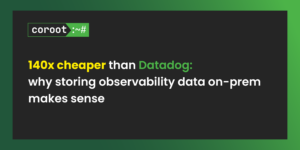You are running a complex, mission-critical application, and you understand you need an advanced Observability solution to efficiently troubleshoot and proactively prevent issues. Yet you have a choice to make—should you choose a “Fully Managed” SaaS solution such as Datadog, Newrelic, or Dynatrace, or should you pick an Open-Source solution that you can host yourself?
There are many self-serving pitches by Cloud Observability vendors, suggesting that using a SaaS solution is the only reasonable way because a company should just focus on its core business and let specialists handle the rest.
The problem of course is having a SaaS vendor to handle Observability for you can get very expensive.
In this blog post, I wanted to provide an alternative point of view, not entirely unbiased, on your choices.
This article is written with Coroot in mind, but most thoughts in this article would equally apply to other Open Source/Open Core observability solutions.
First. There is a number of companies, for which SaaS Observability makes sense, despite it being expensive. Some companies, especially with smaller infrastructure as related to their business size, are just not very price sensitive, and let’s give it to SaaS options – they can provide fantastic usability and ease of use. So yes, there is a space for “Fully Managed” SaaS Observability solutions.
Let’s now look at the cases where I believe Self Hosted Open Source Observability makes more sense.
Early Stage companies with strong technical team
Very early-stage startups, companies that are being bootstrapped or before attracting significant investment rounds tend to have skills to figure things out and more time than money on their hands. For those companies using Self-hosted observability solutions makes a lot of sense, as they come essentially “free” in terms of required hard cold cash. Even infrastructure costs often can be mitigated as such startups may be relying on “cloud credits” to be able to run their infrastructure for free. Such companies also often are served well enough by “Community” versions of software and rely on self-support/community support rather than require commercial support.
The nice thing about small and simple environments is you can often use Open Source Observability in the most simple way, requiring almost no effort to “maintain” it.
Mid-Size Companies
As companies grow their infrastructure and application complexity tends to increase too and so do SaaS observability costs. This is also where the cost of time becomes recognized, and management may start thinking about something like TCO (Total Cost of Ownership) rather than seeing Open Source Software as Free (as in beer). As such companies often start to prefer Enterprise Subscriptions to get access to the most advanced features and see the value in commercial support, as they want to be in a position to resolve problems in their observability infrastructure in the most effective way possible.
Some Mid-Size companies have members of their technical team comfortable having additional responsibility to maintain their Observability infrastructure, especially with vendor’s commercial support and consulting services, others prefer to outsource this task by hiring a third party to be responsible for their Observability Infrastructure – this is what I refer to as “Managed Services”
Large Technology Companies
While all Large companies tend to rely on a lot of technology those days there tend to be significant culture differences between companies such as Meta, Google, and Shopify which are built around technology versus oil companies, hospitals, and airlines, which while use a lot of technology, often see it as a way to optimize their business. This classification is not black and white but I think most engineers know in what company (or division) they are working at.
Large Technology companies tend to have very large infrastructure and so using SaaS observability solutions becomes extremely expensive, even for their massive technology spend. These companies also often have very large scale and special needs so “out of the box” solutions may not serve their needs well and being able to make Open Source software better for their needs is important for them. As such they are often “assembling” the Open Source solution they want to have from Open Source components and contribute their improvements back to upstream, or sometimes run their special forks internally.
These are also the companies that are the most vulnerable to NIH (not invented here) syndrome and may have a tendency to re-implement things in their own way, rather than learning how to use existing solutions best.
Such companies may have a whole “Observability Team” responsible for running their observability infrastructure, in this case running self-hosted, self-managed solutions are particularly attractive.
For Open Core projects, they may choose to run the Open Source version as they have the skills to extend it in the most critical areas or subscribe to the Enterprise edition, to benefit from additional features and commercial support, while the Observability Team tends to have software specific skills and experience they are usually no match for depth and breadth of experience, those who created Open Source project have.
Large Enterprises
Large Enterprises, not coming from the technology industry, tend to be more conservative with technology choices and have more preference for buying technology than developing it in-house. They too have significant infrastructure to be covered by Observability and often have quite a mix of technologies in use, including quite often very “legacy” tech stack – because many of those companies have been around for many decades. They often also tend to have significant budget discipline as such “wasting” money on a high-cost approach to Observability will have have impact elsewhere.
Such companies often care about compliance a lot and have a lot of internal policies, meaning relying on someone on the team being able to “figure it out” with the help of the Open Source community is not an approach to their Observability they will take.
Some of such companies still have Observability, Platform, or some other team that will be excited to take on responsibility for inhouse Observability solution, in which case Enterprise Subscription tends to work well if not Managed Services is the optimal solution.
Are not “Managed Services” just poor imitation of SaaS?
As you see I’m pitching Managed Services a lot, and indeed I do. If your team does not have the desire or experience to “own” running your Observability Platform 24/7 Managed Services is a great choice.
But is not a Fully Managed “SaaS” solution from the cloud vendor offering the same thing, just better, because of “economy of scale”
First, let me tell you a secret – while there might be economies of scale, it is often overtaken by greed which increases as companies scale. Can you come up with many examples of when small startups have grown to become large and successful companies, went public, and… lowered their prices? The opposite though happens every day!
And the worst thing, is if you’re running a Proprietary Fully Managed SaaS solution you’re basically fully at the vendor’s mercy. Migration costs are high, which every MBA knows gives you price increase leverage.
If we’re looking at Open Source Software, though, there are typically multiple vendors who you can hire to provide Managed Services solutions, and you also have the option to bring this experience in-house if you like.
If you’re running an “Enterprise” version of Open Core software (like Coroot), indeed you need to maintain commercial relationships with vendors. So how is it different from SaaS?
First, in proper Open Core software, the Open Source software version is very powerful, so if things go really bad in vendor relationships you can move to Open Source edition, potentially with custom patches to provide for the key functionality you need which Open Source version does not provide.
Second, the Enterprise Edition Subscription to self-host, at scale, should cost a fraction of what the SaaS solution costs. This is surely the case with Coroot. If this is not the case you’re dealing with a vendor who does not want to be in an “Enterprise Subscription” business and uses unattractive prices to drive customers to their SaaS offering.
Summary
To finish it up – I believe no matter what kind of company you are and at what stage you are chances are you can achieve more cost-effective observability through self-hosting Open Source/Open source software.
Whenever you should run the “Community” version or “Enterprise”, just rely on Community Support, Commercial Support or Managed Services will vary.
If you’re looking to better understand what is the right choice for your situation, I would be happy to talk to you, even if you’re considering Open Source observability options other than Coroot. I can be reached at pz@coroot.com





